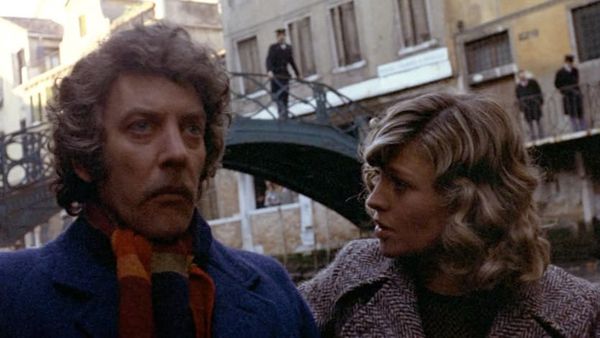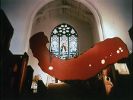Eye For Film >> Movies >> Don't Look Now (1973) Film Review
Don't Look Now
Reviewed by: James Benefield

In Don’t Look Now Stanley and Laura Baxter have to face an unimaginable tragedy: the loss of a child. Probably the finest in Nicholas Roeg’s quartet of Seventies masterpieces (the others being Performance, Walkabout and The Man Who Fell To Earth), film language is deconstructed and genre is transcended to deliver a devastating, emotional and highly metaphorical horror film, which gave birth to a cinematic influence that is still felt today.
Following the accidental drowning of their daughter in sight of the family home, Stanley and Laura (Donald Sutherland and Julie Christie) temporarily decamp to an off-season Venice, leaving their son at boarding school. Stanley is there helping to restore a church, but both are clearly trying to escape the trauma’s aftermath. Early on, Laura encounters two other Brits: a pair of sisters staying close by. One of the pair is a psychic, who tells Laura not to despair as her little girl is in the next world, happy and laughing. After initially rejecting the sisters, Laura goes on to embrace their off-kilter interest in her daughter, much to her husband’s dismay. Meanwhile, still obsessed by the death of his little girl, Stanley keeps seeing a small figure, in a similar red raincoat to the one in which his daughter died, running around the backstreets of the city.

The first point of the interest in the film is its technical accomplishment. Nicholas Roeg began his career as a director of photography, and his keen, experienced visual eye permeates the film. The film exists in a muted colour palette; it’s these auburns, beiges and greys that really accentuate the harsh red that comes to stand for the daughter, cropping up at several key moments in various different guises. This sense of contrast also extends to the editing, in which jump cuts are used effectively (for both flashbacks and flash-forwards), and there’s a piece of sound editing towards the beginning of the film which easily rivals the famous helicopter/ceiling fan transition in Apocalypse Now.
As with all great horror, the film uses genre conventions and staples to discuss something else; here the main source of satisfaction comes from the treatment of grief. It’s a genre staple, and evidence that Seventies horror cinema was very male-dominated and perhaps a little scared of girls, that women (and, in other movies, children and animals) in horror flicks tend to be the first to embrace the supernatural; a more unknown, mysterious force. In this instance, Laura embraces it because of her loss, and explicitly rejects a conventional religious solution. She tells a bishop she doesn’t know if she is a believer; indeed it is seen in the film as something that only offers faith and hope rather than anything visceral, direct or tangible. It is only the blind, psychic woman who offers this. Stanley’s ways of dealing with the loss are also almost completely secular; they can be seen through his pursuit of the red-hooded figure, and throwing himself into his work on the design of the church.
Although we know the answer by the end, it’s almost immaterial as to whether the red-hooded figure stalking the city’s streets is actually the daughter. It’s significant that Stanley sees this person, whilst his wife does not pay very much attention. Laura embraces the help of the psychic, and uses the revelations and channelling of the daughter’s thoughts and feelings to embrace and start to overcome her own pain. We’re posed the theory that ultimately it does not matter whether the psychic is a charlatan or not, if she delivers this positive result. Stanley, however, does not have an emotional outlet, perhaps too constrained by his practical, spiritually sceptical masculinity. He’s too busy putting things back together in his job restoring the church, too busy to take his feelings apart.
All of this visual and intellectual discourse is tied together with two excellent central performances. Julie Christie always manages to seem both luminous, in her talent and her beauty, and down-to-earth and relatable. This is no exception. Donald Sutherland does cynical and furrow-browed particularly well, and here he underscores this with acute pain, which only very occasionally breaks through to the surface.
The famous sex scene, in which the couple release their pent-up emotion, works all the better because of the performances bookending it. It’s a beautiful moment, not least because of the way it is tastefully edited with shots of the couple getting ready for dinner afterward, but mainly because of its candid, unglamorous nature. It looks like it’s lit by daylight, there’s no soft focus and the camera captures the couple’s faces as much as their naked bodies. It’s proof that you can get a realistic love scene without elements of hard pornography, which have recently become fairly de rigeur.
The film ends in a way that is simultaneously unexpected, poignant, provocative and cathartic. Although it does look a little dated in execution now, the intention is still clear, and it’s one that will still be debated and talked about by audiences. Ultimately, it’s the final part of a very rich, rewarding experience. On the one hand, it is a movie encased in sadness, where the real horror is not the supernatural but the very, very real. However, on the other hand, it’s a film that reminds us how much love and beauty there is in this world, and that we should cherish it, as one day it will be gone.
Reviewed on: 09 Jul 2009
















